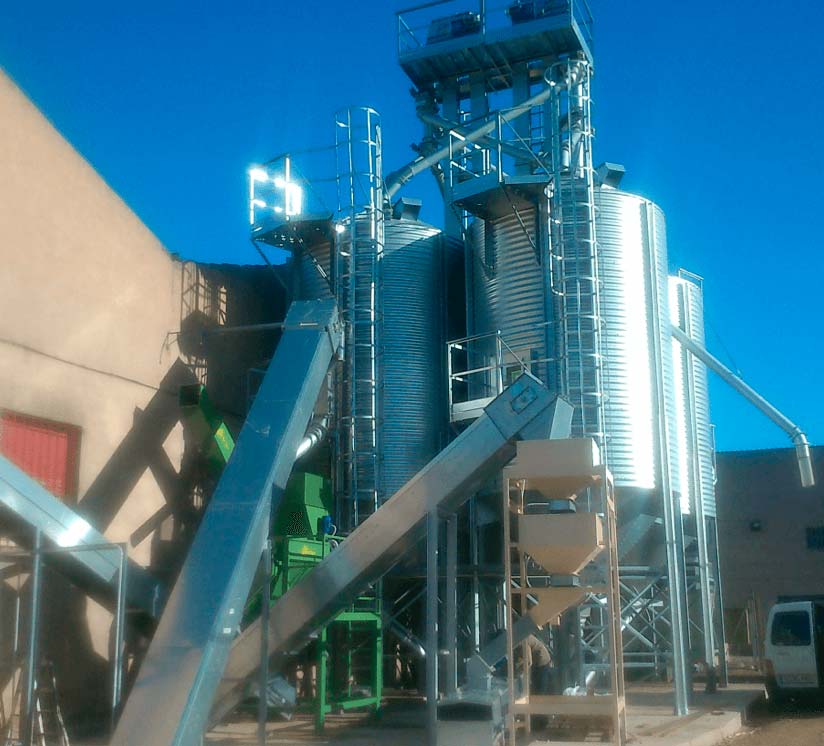In this article, we will delve into the benefits of drying and storing almonds in silos to meet the quality standards demanded by the markets.
The almond tree is widely recognized as a highly profitable crop in the present times. Given its social demand and inherent characteristics, it serves as an excellent alternative for production. However, apart from cultivation itself, it is crucial to pay close attention to proper harvesting and post-harvest processes.
To ensure optimal preservation of the harvested almonds, particular emphasis must be placed on the drying and storage procedures. These steps are of utmost importance and require delicate handling, as they directly impact the quality and market value of the nuts.
General aspects of almond drying and storage
Almond Drying. The drying process of almonds typically commences with destemming and venting, followed by skinning using a dedicated machine.
To ensure the product can be stored with optimal sanitary conditions and preservation, it is crucial to reduce the moisture level to 5-6%.
Traditionally, drying is done outdoors, utilizing the sun, and occasionally within a warehouse. Regardless, it is essential to maintain a relative humidity below 65% and an average temperature of 25ºC.
Almond Storage. Once the almonds are dry, they are stacked into piles for storage. The ideal conditions involve maintaining neat piles with a slight incline to facilitate moisture drainage and promote good aeration. Similarly, the relative humidity should be kept below 65%, while the temperature is maintained between 10ºC and 15ºC.
Failure to implement appropriate measures can lead to the emergence of worms or even fungi, which can pose a significant threat to the entire harvest. Aspergillus spp, a ubiquitous fungus, can rapidly colonize inadequately dried almonds. This fungus produces aflatoxins, a hazardous substance to human health.
Another potential issue is almond rancidity. All of these problems are directly linked to the presence of humidity, often accompanied by heat. Therefore, drying should be conducted in well-ventilated and dry environments.
The aforementioned drying and storage processes require substantial labor and meticulous control of the product to ensure its arrival in the market under optimal conditions and without any production losses.
Furthermore, it is worth noting that a considerably large surface area is necessary for drying and storage when aiming to produce a high-quality product.
Considering these factors, it becomes evident that modernizing the process and minimizing risks in drying and storage is essential to overcome potential challenges associated with atmospheric changes, such as rainfall, dew, or high temperatures.
Advantages of Almond Drying and Storage in Silos
Drying almonds in a silo is one of the most efficient systems available today. When compared to sun-drying or drying in a warehouse, the advantages are significant:
- Efficiency. No requirement for extensive space or a large workforce (a single person can manage a drying and storage facility).
- Enhanced control processes without being influenced by external weather conditions.
- With a constant heat source, drying occurs rapidly, preventing product contamination and ensuring optimal storage conditions.
How Does a Drying Silo Work?
To achieve optimal performance from our drying silo, it is essential to adjust the dimensions based on the peeling production capacity of the plant. The drying silo is constructed as a hopper silo on a metal structure, featuring a 45º cone.
Internally, a slide is installed to prevent almonds from breaking during descent, along with a fully perforated counter cone equipped with an air inlet connection. The counter cone facilitates product discharge following the FIFO (first in, first out) principle.
A centrifugal fan, connected to a hot air generator, is attached to the connecting tube. This hot air passes through the counter cone, effectively drying the almonds.
Additionally, an air extractor is incorporated into the ceiling to prevent internal condensation and remove excess hot air.
The drying time may vary depending on the initial humidity of the product and typically ranges between 8 to 10 hours.

Almond Storage Silo
The silo is undoubtedly the optimal choice for almond and nut storage, offering numerous advantages for their conservation and handling.
Here are the benefits it provides:
- Easy ventilation and temperature control, if necessary (compared to warehouses, where achieving such control is more complex and expensive).
- Requires less space for implementation compared to other storage systems.
- Eliminates product losses due to breakage, rodent infestation, and other factors.
- Ensures consistent product quality for subsequent sale and handling.
- Reduces handling and labor costs compared to traditional warehouses.
Investing in a silo is a wise decision when aiming to achieve a high-quality product that meets the demanding standards of the market.
More information on drying and storage of nuts in silos and related projects worldwide: Nuts storage




